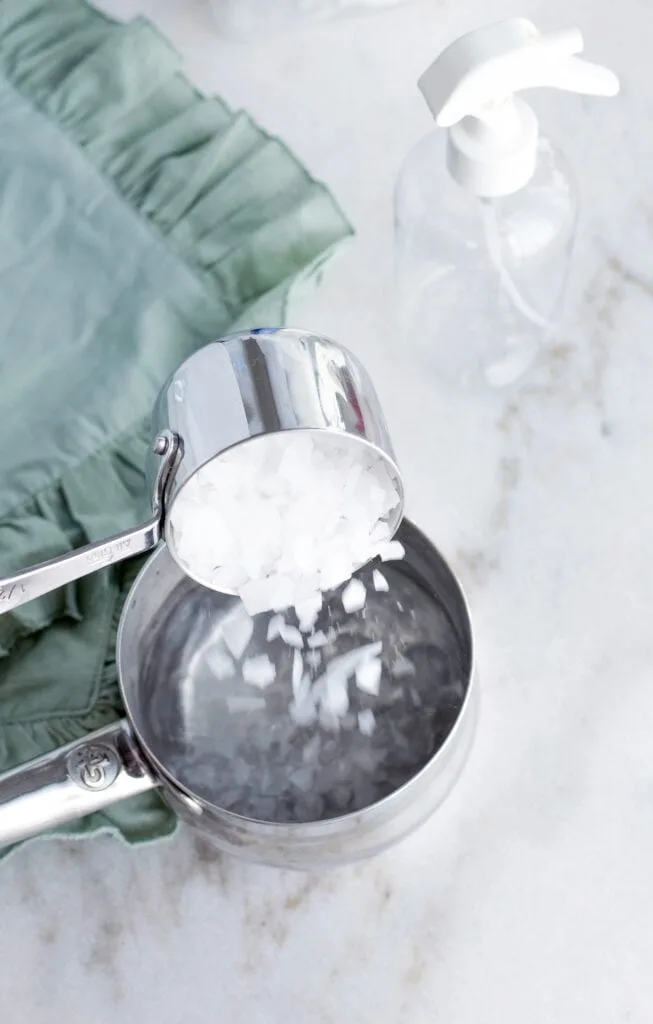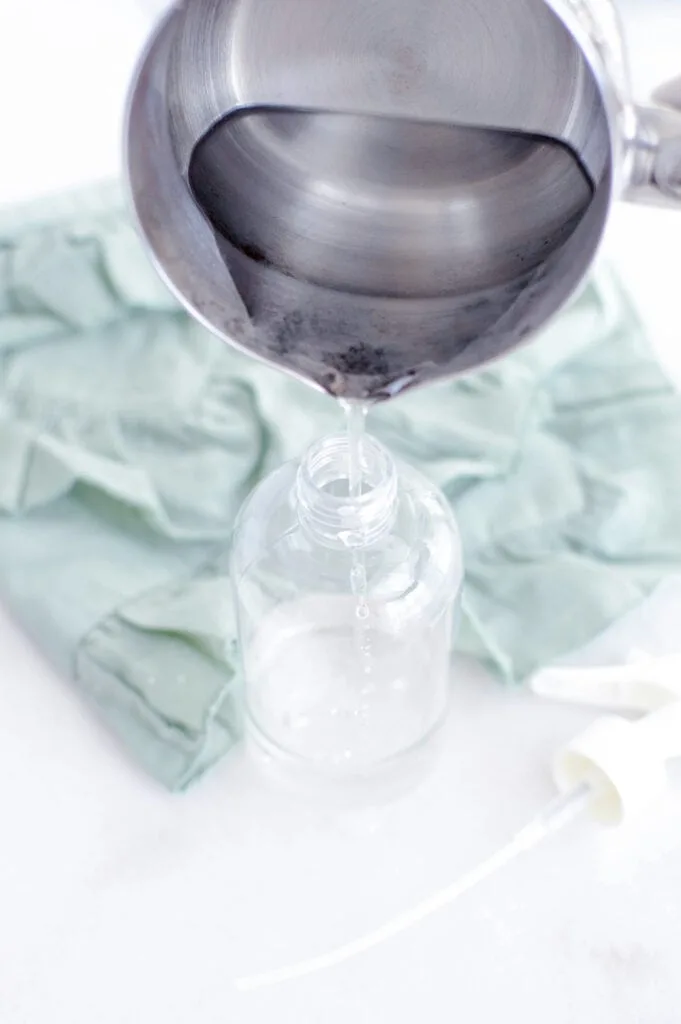Magnesium topical spray can naturally help relieve leg cramps and back pain, promote better sleep and lessen anxiety. Here’s an easy magnesium spray recipe to try today.

If you are wondering about the benefits of a magnesium topical spray, you are not alone! The natural powers of a magnesium oil spray are just starting to become well known. Which is a good thing since a magnesium spray is so simple to use. And it is only made of two natural ingredients.
What is a Magnesium Spray?
A magnesium topical spray is just what it sounds like. It is a liquid that contains magnesium that can be sprayed on your skin. Really, it’s just magnesium flakes dissolved in water to make the liquid spray.
Also known as transdermal magnesium, this spray absorbs into your skin.
So your body is absorbing and getting magnesium through your skin. Without needing to swallow a pill.

Many people cannot tolerate ingesting a magnesium pill because it causes stomach upset. High doses taken as a pill can lead to a laxative effect. I have to admit, I have a lot of digestive disturbance when I take a magnesium powder. Which makes me not want to take it so that my stomach isn’t upset.
With a magnesium topical spray, the magnesium is absorbed through your skin immediately. It goes into your blood vessels and muscles without having to first go through your digestive system.
Which means a magnesium topical spray can get to the places in your body that need the mineral most quickly and efficiently.
***While this is typically called a magnesium oil spray, there actually isn’t any oil in the spray. The way the magnesium breaks down into the water creates an oil-like consistency.
Different Types of Magnesium – Which One is Best?
If you have ever looked at magnesium supplements, you might have realized that there are many different types of the mineral. Which can be very confusing.
Magnesium citrate is most commonly used in supplement and pill form. It can be a little difficult on the digestive system in some people. And it’s not a great choice for applying to your skin, because it can be irritating.
Magnesium topical spray is made from magnesium flakes. And magnesium flakes are also known as magnesium chloride.
Did you know that magnesium is the 8th most abundant element in the crust of the Earth? Yep. And that’s where magnesium flakes come from.
We like using Ancient Minerals Magnesium flakes, from the purest magnesium source in the world. It’s located in the Zechstein Seabed, which is 1,500 meters underground. And it’s been 250 million years in the making.

Ancient Minerals magnesium flakes can be added directly to bath water to get the same benefits. However, if you don’t want to have to take a bath to apply magnesium to your skin, our magnesium spray recipe uses these same flakes in a spray form for easy application.
You can buy Ancient Minerals Magnesium Oil Spray already made. But it does cost a bit of money and you can make more bottles of it for cheaper with our magnesium spray recipe.

What about Epsom salts? Don’t they have magnesium, too?
Yes, Epsom salts are magnesium sulfate. Again, it’s a good way to get the mineral transdermally by soaking in a tub. But magnesium chloride in a magnesium topical spray is better suited for spraying on your skin, rather than having to soak in it.
Magnesium Spray Benefits
There are many benefits to absorbing magnesium through your skin.
Magnesium is a mineral that the body needs. But it’s estimated that 80% of people DON’T have enough magnesium in their body.
That’s a BIG PROBLEM! Because the mineral magnesium helps
Which is why if you start using magnesium topically, you could suddenly get relief from many problems you have today. Including:
- Promotes better sleep
- Relieve back pain
- Relieve leg cramps
- Can help decrease anxiety
- Calms the nervous system
- Prevents stomach upset
- Quick acting
- Helps your body absorb calcium
- Replenishes magnesium lost through sweating
- Works well to relieve muscle cramps

DIY Magnesium Spray Recipe
It’s hard to even call this super simple DIY a recipe. Because it’s just mixing two ingredients together.
Ingredients
- ½ cup high quality magnesium flakes
- 1 cup of distilled water (distilled water helps keep the oil longer and extend the shelf life)
- Essential oils (optional, but if you would like to add them, consider a calming scent like lavender)
Supplies
- Spray bottle (I prefer a glass spray bottle)
Directions
- Bring the water to a boil.
- Mix in the magnesium flakes and let them dissolve. You may stir continually or stir once and let them dissolve on their own. This will take about 20 minutes.
- Cool the mixture.
- Transfer to a spray bottle.
- Store in a cool place preferably out of direct sunlight, if possible.
How to Use Magnesium Spray
It is very simple to use magnesium oil spray. Just spray on your skin and absorb the mineral! That’s all there is to it!
Aim for 10-20 sprays in total a day. Start with just one or two sprays at first, and work your way up depending on tolerance and tingling.

You can leave the spray on your skin to naturally absorb. Or rub the magnesium spray into your skin for quicker absorption. Your hands might feel slightly sticky afterwards. This is completely normal.
Ideally, you would like to spray on clean skin. Many people like using this spray when they get out of the shower. It is easy to apply on bare skin before putting on clothes.
As long as you’re not a dirty, grimy mess, though, I say you are able to use magnesium topical spray whenever you remember so that you get all of the benefits!
If there is a specific place on your body where you want relief, such as a joint, always be sure to spray the magnesium there.
However, magnesium spray can be applied liberally anywhere, including:
- Arms
- Back
- Legs
- Stomach
- Shoulders
- Neck
- Feet
Where to Apply Magnesium Spray for Leg Cramps?
If you are suffering from leg cramps, be sure to spray magnesium on your legs directly.
You can apply to your entire leg to have the mineral absorb into all muscles in your leg. But pay special attention to the part that is cramping.

Where to Spray Magnesium Oil for Anxiety?
If you are using a magnesium spray for anxiety, you can apply to pulse points for relief. These pulse points include:
- Back of wrists
- Neck area
- Behind ears
- Crook of your elbow
Using a magnesium topical spray can help alleviate anxiety wherever you put it. So there is no need to worry about putting it on wrong. However, these points generally are where blood vessels are close to the surface of the skin.
A weighted blanket can also help to ease anxiety throughout the day. These are the best weighted blankets for anxiety we have found.
Natural Calm is a magnesium supplement taken internally that can help alleviate anxiety. I have found it too strong for my digestive system, but it can be another alternative for relieving anxiety and stress. It’s great because it’s a powder and can easily dissolve in water, hot tea or a smoothie.
The Natural Calm supplement is just one of five natural supplements that I have tried to relieve anxiety and stress.
Where to Apply Magnesium Spray for Sleep?
Again, spraying the oil anywhere on your skin will get the mineral into your body.
However, many people report that when they apply magnesium topical spray to the bottom of their feet, it helps promote better sleep and relaxation.
It’s an easy place to apply the spray without having to take off clothes for application. So if you have a bottle of our magnesium topical spray on the bedside table, you’ll be able to quickly apply it before you go to sleep.
For better sleep, also check out our guides on the best bedroom plants for better sleep and how to declutter your bedroom to sleep better.
Pin It to Share or Save for Later

Why Does Magnesium Spray Sting?
Sometimes – not always – magnesium oil spray can sting when you apply it to your skin.
Is that bad? Should you be worried? Probably not.
Usually, a slight stinging sensation can occur if your body is low in magnesium. Which is when you need it the most.
But I have found that it depends on where you apply magnesium topical spray as to whether or not it stings.
For instance, I’ve applied it to my feet with no stinging. However, when I applied it to my neck and shoulders, I did feel a little bit of stinging. Kind of like when the salt in ocean water dries on your skin in the hot sun. Not really painful, but you are aware of it.
Ironically, my shoulders and neck are where I store the most tension. So maybe those muscles are in the greatest need of magnesium.
The stinging didn’t prevent me from using it. If you do have a lot of stinging and it’s painful, you can wipe off the spray after a few minutes.
Keep in mind, the longer you allow it to be on your skin, the more will absorb transdermally. But you should never be miserable just for the sake of having the mineral absorb into your skin.
You can also add more water to the spray recipe, which will dilute the magnesium more.
If you have broken skin, blistered skin or other problems that would make applying a mineral not wise or healthy, then don’t apply a magnesium topical spray.
For any and all concerns, talk to a doctor or physician. I am not a medical professional, so I can’t tell you whether or not to apply the spray.
See our easy DIY Jewelweed spray to soothe itchy skin next.